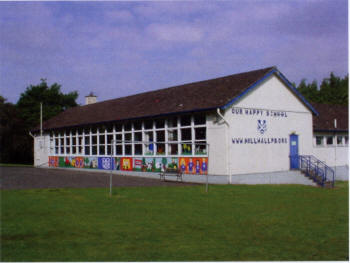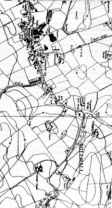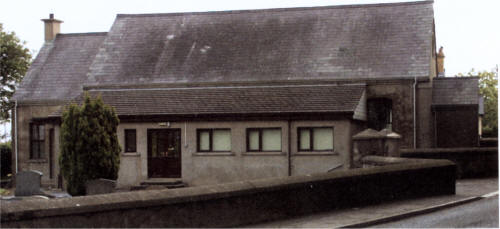|

An Historical Background
Hillhall (2) Public Elementary School
Hillhall Primary School is situated off the busy Hillhall Road at Orr's
Lane on the outskirts of Lisburn. It is very much the centre of the
rural community and has close links with Hillhall Presbyterian Church.
We keep in touch with past pupils and members of staff.
On an early Ordinance Survey Map, the school adjoining Hillhall
Presbyterian Church is marked as Hillhall School No.2. Although not
mentioned on the same map School No.1 was situated on the main Hillhall
Road � now known as No.285. The No.1 School was in the Parish of Drumbeg
and possibly was managed by the Minister and Select Vestry of the Parish
Church. It ceased to be a school around 1930 and was converted into four
houses: the families attending the school at Hillhall Presbyterian
Church. These houses were demolished in the early 1970's and a bungalow
erected nearer the roadway.
Church records state that No.2 School was erected in 1893, the
present Church being opened in 1902.
Little is known of the early years of schooling within the building.
Records of the Local School Management Committee Meetings are available
only from the late 1930's. The following are a few extracts taken from
those meetings: -
A meeting of the newly appointed Local School Management Committee
was held in the School Room on 15th March 1938.
The following were unanimously elected as Office Bearers:
Rev Duff Chairman
Mr Dick, Vice-Chairman
Mr Topping, Honorary Secretary
During the years 1938-48, much discussion took place regarding the
'condition of the school premises.
At a quarterly meeting of the Local School Management Committee held
on 2nd March 1948, discussion took place with regard to the expiration
of the Lease in September 1950.
The reason the Church did not wish to renew the lease was because
Hillhall Presbyterian Church was growing and required the premises for
Church and Sabbath School activities.
Hillhall Church Committee wrote to the Education Authority asking hem
if they would be agreeable to pay a rent of �300 per annum for he use of
the Church Hall as premises. This rent was to take effect from 1st
September 1950.
The Education Authority agreed the payment of rent.
At a meeting of the Down County Education Committee in November 948,
it was suggested that the time had come for the Local School management
Committee to look around for a suitable site on which to build a school.
With this in mind, the Church Committee was requested to extend the
Lease for a further period, i.e., until a school was built.
The Church Committee agreed to this request.
A meeting of the Local School Management Committee was held on 15th
September 1949. Mr Allen, a Parents' Representative, took the Chair.
Mr Allen submitted a letter from the children's parents attending
Hillhall Primary School. The parents were extremely anxious that the
children should not be transferred to other schools and they urged the
Education Authority to expedite the matter of providing a school for the
district.
Mr Topping, the Honorary Secretary, was instructed to forward the
request to the Director of Education � Down County Education Committee.
Within two weeks of the parents' request being submitted to the DCEC,
the Director of Education and three members of his Committee visited the
School. During their visit they looked at sites for the proposed new
school.
Mr Bell and Mr Gillespie, two local farmers, had land which the
Ministry was keen to obtain, but Mr Gilliland's field, known locally as
The Camp Field' (occupied by the Army during the Second World War), was
suggested as the most suitable site as it already had mains water and
sewage facilities.
After much consultation, Mr Gilliland's field was acquired and on
19th August 1952, Hillhall Primary School was opened for pupils.
Extracts taken from the Minutes of the Local Management Committee
meetings, compiled by Mrs M Megarry, a previous member of the Board of
Governors.

Hall of the Hills
In 1573 Moyses Hill arrives in Ireland as an officer under the Earl
of Essex, Walter Devereux. When Walter Devereux died Moyses served under
Robert Devereux who was Lord Deputy in
1598. Later Moyses Hill was made Governor of Olderfleet Castle at
Larne and then in 1603 he was knighted. In 1617 he was made the first
Provost Mareschale of the Province of Ulster.
 In
recognition of his services Sir Moyses Hill was granted 2,000 acres in
County Antrim and 40,000 acres in County Down. Moyses married Alice
McDonnell sister of Sorley Boye MacDonnell of Dunluce. For a time Sir
Moyses lived near Carrickfergus before moving to the County Antrim side
of the river Lagan at Upper Malone. He eventually took up residence near
Lisburn at a fortified house called Hill Court. (See Map) He and Alice
had three daughters and a son. Alice died shortly after their son Peter
was born and later Sir Moyses married his second wife, Ann Grogan. On
the death of Sir Moyses, Peter inherited the entire family estate, which
had grown considerably owing to land having been purchased from Sir
Robert McNeill by Sir Moyses in 1625. In
recognition of his services Sir Moyses Hill was granted 2,000 acres in
County Antrim and 40,000 acres in County Down. Moyses married Alice
McDonnell sister of Sorley Boye MacDonnell of Dunluce. For a time Sir
Moyses lived near Carrickfergus before moving to the County Antrim side
of the river Lagan at Upper Malone. He eventually took up residence near
Lisburn at a fortified house called Hill Court. (See Map) He and Alice
had three daughters and a son. Alice died shortly after their son Peter
was born and later Sir Moyses married his second wife, Ann Grogan. On
the death of Sir Moyses, Peter inherited the entire family estate, which
had grown considerably owing to land having been purchased from Sir
Robert McNeill by Sir Moyses in 1625.
Peter set about building a strongly fortified mansion on the site of
the Hill Court. It had turrets and loopholes and the surrounding
countryside was overlooked by a large number of cannons. It is said that
the entrance archway was guarded by to enormous guns. This stronghold
became known as Halls of the Hills and the district ultimately became
known as Hillhall.
It was Peter who built the fort at Cromlyn the ancient name for the
present day Hillsborough. Cromlyn had been the stronghold of the Magenis
family. Peter also laid plans for the village and the church at
Hillsborough.
Compiled by Mr. J. McAteer (Flowerhill 328 Review Feb. '92)
Contributed by Alan Toole, former pupil.

Hillhall Primary School prior to1952
Photography Courtesy of J Kelly

Teaching Staff 1952 � 2007
Principal Teachers
|
Mr A Topping Retired in April 1955 after almost 28 years service
in both old and new schools. |
|
Mr R M Johnson |
April 1955 � August 1956 |
|
Mrs E Thompson |
August 1956 � December 1972 |
|
Mrs M McKeag |
January 1973 � December 1992 |
|
Mrs E A Moore |
January 1993 - August 2007 |
|
Assistant Teachers |
|
Mrs E Thompson |
1936 � 1956 |
|
Mrs Frizelle |
1956 � 1961 |
|
Mrs Price |
1961 � 1970 |
|
Miss Black |
1971 � 1973 |
|
Miss Campbell |
1973 � 1980 |
|
Mrs F Elliot |
1980 � 1986 |
|
Mrs M Millar |
1986 � 1997 |
|
Mrs H Young |
1997 � 2007 |
|
Miss S Halliday |
1999 � 2007 |
|
Part-time Teachers |
|
Mrs J Robinson |
1990 � 1998 |
|
Mrs V Kirk |
1994 � 2003 |
|
Mrs L Casement |
2003 � 2007 |
|
Caretakers of the School 1952 � 2007 |
|
Mrs Shirlow |
Mr H Ferguson |
Mrs E Mcllroy |
|
|
Mrs M Simpson |
|
Although I taught at Hillhall Primary School for a short time it has
remained in my memory ever since as a place where I experienced some of
the happiest times of my teaching career.
I went to Hillhall from a large Belfast School where each teacher was
responsible for his/her own class only, but now I had to arrange lessons
for four different groups and keep each child all day.
Right from the start I received much help from the children
themselves and, of course from Mrs. Thompson, my assistant, who was a
tower of strength in helping me to settle in.
The senior boys and girls (this was in the days before they had to go
off to the Lisburn Secondary Schools) kept me right about "priming" the
pump, keeping the heating going, cutting the grass and keeping the
grounds tidy. I remember we had a corncrake quite near to the school and
we took great pleasure in protecting it.
Some of the names of my pupils I remember -The Simpson Family; Josh
and Jim Rush; Valerie and Hugh Crookshanks; Emily and Albert Megahey and
others too numerous to mention, like the Lockhart's.
I lived in Lisburn in those days and rode a bicycle to school so that
I knew the area and the local farmers very well.

Mr R M Johnson
Principal 1955 � 1956
Thoughts of Hillhall
My thoughts go back 70 years go and more to my first days in Hillhall
School, then in the Presbyterian Church Hall. The village at one time
supported two schools but the other was long gone and the building
converted into houses.
One large room divided by a dark green curtain (rather the worse for
wear) held the junior and senior classes. A smaller room at the back of
the hall, euphemistically called a kitchen, was the cloakroom. Black
stoves, fuelled by coke, heated all three rooms. I shudder to think what
the fumes did to our lungs. Only desperation drove one to the toilet
down the lane! The lane was also our playground.
Mr Topping, the Headmaster, taught the seniors aged 9 � 14 and I, the
juniors. The strain of keeping the noise to an acceptable level was
tremendous, but with timetables geared to each other's needs we managed.
Mr Topping's pride and joy was the school garden beside the Manse
entrance gates. It must have been a huge relief for both pupils and
teachers to enjoy the freedom there.
To me the most frustrating aspect of those early days was the
inability to display the pupil's work and the necessity to lock
everything away daily. Textbooks and stationary were at a premium and
were meticulously conserved, and the arrival of a new map or teaching
aid was a great occasion. When the Education Authority provided a
folding, wooden partition it was the height of luxury.
The war brought about many changes, chiefly the arrival of evacuees
from Belfast. Not only was there no equipment for the newcomers but also
there were no seats or desks. At one time we had 120 children to look
after, until finally 1 was transferred to the Orange Hall with the
middle group, and an extra teacher came for the juniors. A modicum of
order was restored, and with the ending of the war normal working was
resumed.
The growth of the church and changing aspects of education were
working for us and aiding our determination to have a new school. I
would like to pay tribute to Mr Topping, for without his persistence and
lobbying of Education Officials we would never have succeeded, the
economic conditions in then aftermath of the war were against it. But
land was acquired, plans approved and in 1952 the dream became a
reality.
Moving days were hilarious. Not for us the sophistication of a
removal firm. Equipment, records, stationery, books etc. were packed and
trundled down the road on wheelbarrows, trolleys (lent by Mr Walker) and
anything on wheels. Even the old desks had to be taken. But it was a
labour of love and all was in readiness for the new term in August. A
Parent Teacher Association was formed, and a tremendous `thank you' is
due to the parents whose efforts provided us, not with `the icing on the
cake' but the essentials, which the Education Authority thought were
unnecessary. Many parents will remember the request for a piano and the
absurdity of the partial cost suggested by them. The jumble sales held
in the Market Hall in Lisburn were a great source of income, never mind
the fun of wheeling and dealing.
To teachers and pupils alike it was a new world. The extensive
grounds, freedom of movement, cloakroom facilities, space for displays
and projects, suitable furniture, and above all the feeling that it was
`our building' in which we could take immense pride and pleasure.
Mrs E Thompson
Assistant Teacher 1936 �1956
Principal 1956 �1972

Past Pupils of Hillhall Primary
Photography Courtesy of J Kelly
 |